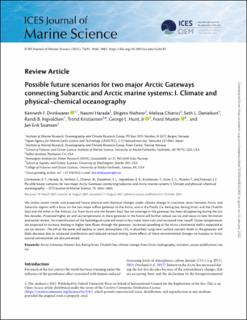| dc.contributor.author | Drinkwater, Kenneth F. | |
| dc.contributor.author | Harada, Naomi | |
| dc.contributor.author | Nishino, Shigeto | |
| dc.contributor.author | Chierici, Melissa | |
| dc.contributor.author | Danielson, Seth L. | |
| dc.contributor.author | Ingvaldsen, Randi Brunvær | |
| dc.contributor.author | Kristiansen, Trond | |
| dc.contributor.author | Hunt, George L. | |
| dc.contributor.author | Mueter, Franz | |
| dc.contributor.author | Stiansen, Jan Erik | |
| dc.date.accessioned | 2022-01-18T13:47:13Z | |
| dc.date.available | 2022-01-18T13:47:13Z | |
| dc.date.created | 2021-12-31T16:34:28Z | |
| dc.date.issued | 2021 | |
| dc.identifier.citation | ICES Journal of Marine Science. 2021, 78 (9), 3046-3065. | en_US |
| dc.identifier.issn | 1054-3139 | |
| dc.identifier.uri | https://hdl.handle.net/11250/2838001 | |
| dc.description.abstract | We review recent trends and projected future physical and chemical changes under climate change in transition zones between Arctic and Subarctic regions with a focus on the two major inflow gateways to the Arctic, one in the Pacific (i.e. Bering Sea, Bering Strait, and the Chukchi Sea) and the other in the Atlantic (i.e. Fram Strait and the Barents Sea). Sea-ice coverage in the gateways has been disappearing during the last few decades. Projected higher air and sea temperatures in these gateways in the future will further reduce sea ice, and cause its later formation and earlier retreat. An intensification of the hydrological cycle will result in less snow, more rain, and increased river runoff. Ocean temperatures are projected to increase, leading to higher heat fluxes through the gateways. Increased upwelling at the Arctic continental shelf is expected as sea ice retreats. The pH of the water will decline as more atmospheric CO2 is absorbed. Long-term surface nutrient levels in the gateways will likely decrease due to increased stratification and reduced vertical mixing. Some effects of these environmental changes on humans in Arctic coastal communities are also presented. | en_US |
| dc.language.iso | eng | en_US |
| dc.publisher | Oxford University Press | en_US |
| dc.rights | Navngivelse 4.0 Internasjonal | * |
| dc.rights.uri | http://creativecommons.org/licenses/by/4.0/deed.no | * |
| dc.title | Possible future scenarios for two major Arctic Gateways connecting Subarctic and Arctic marine systems: I. Climate and physical-chemical oceanography | en_US |
| dc.type | Peer reviewed | en_US |
| dc.type | Journal article | en_US |
| dc.description.version | publishedVersion | en_US |
| dc.rights.holder | The Author(s) 2021. | en_US |
| dc.source.pagenumber | 3046-3065 | en_US |
| dc.source.volume | 78 | en_US |
| dc.source.journal | ICES Journal of Marine Science | en_US |
| dc.source.issue | 9 | en_US |
| dc.identifier.doi | 10.1093/icesjms/fsab182 | |
| dc.identifier.cristin | 1973192 | |
| dc.relation.project | EC/H2020/820989 | en_US |
| cristin.ispublished | true | |
| cristin.fulltext | original | |
| cristin.qualitycode | 1 | |

